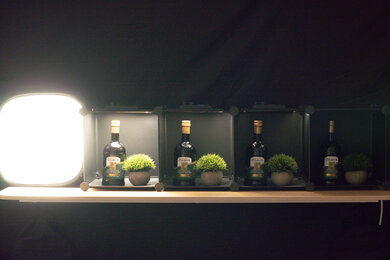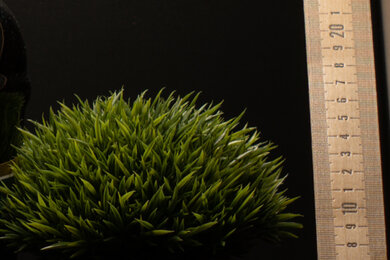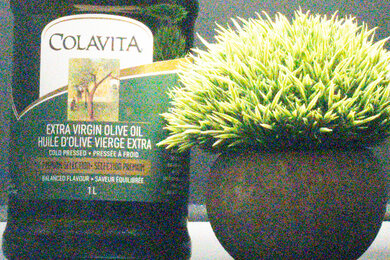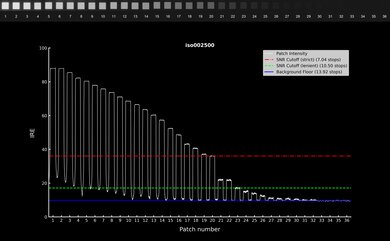First released in 2019, the Sony α6400 is the middle child in Sony's entry-level APS-C Alpha lineup, sitting above the Sony α6100 and below the Sony α6600. Performance-wise, all three are similar, with the same high-res APS-C sensor and Sony's class-leading Real-Time Tracking autofocus. This model is a good middle-ground option, offering better build quality and a higher-resolution EVF than the a6100, but missing the longer battery life and in-body image stabilization of the a6600.
Our Verdict
The Sony a6400 is great for travel photography. It's relatively portable and well-built, with some weather-sealing for more peace of mind when shooting outdoors. Battery life is also quite good relative to other mirrorless cameras. Image quality is generally great, as well, and it's equipped with an excellent autofocus system that can track subjects without issue. That said, its ergonomics and user interface aren't the most intuitive.
- Excellent overall autofocus performance.
- Great photo quality.
- Sturdy, portable design.
- Ergonomics are somewhat lacking.
- Interface isn't especially user-friendly.
The Sony a6400 is great for landscape photography, especially if you're looking for a more portable APS-C camera. It's sturdily built, relatively portable, and weather-sealed, which is good for outdoor shooting sessions at remote locations. Image quality is also impressive overall, with great dynamic range to bring out a wider array of highlight and shadow detail in high-contrast landscapes. However, its user interface isn't especially intuitive.
- Great photo quality.
- Sturdy, portable design.
- Impressive dynamic range.
- Ergonomics are somewhat lacking.
- Interface isn't especially user-friendly.
The Sony a6400 is good for casual sports and wildlife photography. Image quality is impressive, and it has a responsive and fairly reliable autofocus system that does a good job of keeping up with fast-moving subjects. It also shoots at a fairly quick max burst rate to capture sequential moments of fast action. That said, while it has a decently sized buffer, it takes a long time to clear if you manage to fill it up, which can slow you down considerably.
- Relatively quick burst rate.
- Excellent overall autofocus performance.
- Great photo quality.
- Sturdy, portable design.
- Ergonomics are somewhat lacking.
- Interface isn't especially user-friendly.
- Long buffer clearing time.
The Sony a6400 is decent for vlogging. Its screen can be flipped up to help you monitor yourself while recording, but unlike a fully articulated screen, it's easily blocked by peripherals like a microphone on the hot shoe. While video quality is good overall, there's pretty heavy rolling shutter effect, which can cause skewing in the background with quicker camera movements. It also doesn't have in-body image stabilization, so you have to rely on optically stabilized lenses to get less shaky footage.
- Excellent overall autofocus performance.
- Sturdy, portable design.
- Good video quality.
- Disappointing video stabilization performance.
- Screen can be blocked by hotshoe-mounted accessories.
- Noticeable rolling shutter distortion.
The Sony a6400 is decent for studio video. The recording quality is impressive, but there are no high frame rate options in 4k to add slow-motion flourishes. It's also limited to 8-bit recording, even when outputting video to an external recorder, giving you less leeway to edit and color grade your footage. Still, it supports more advanced features like Log recording and has great dynamic range overall. Its autofocus system also does an excellent job of tracking moving subjects and keeping them in focus. The camera doesn't have a recording time limit either, which is good for recording longer takes. While it has a microphone input, there's no headphone jack, which is a little disappointing.
- Excellent overall autofocus performance.
- Good video quality.
- No recording time limit.
- Limited to 8-bit color depth.
- Noticeable rolling shutter distortion.
- No headphone jack.
The Sony Alpha 6400 isn't designed for POV action video. There are few frame rate options in 4k and it doesn't have built-in stabilization. It's sturdy, relatively compact, and weather-sealed, which is good for outdoor recording, but it isn't rugged or waterproof for more extreme action sports.
- Sturdy, portable design.
- Disappointing video stabilization performance.
- Limited frame rate options in 4k.
- Noticeable rolling shutter distortion.
The Sony a6400 has very good RAW image quality. With impressive dynamic range, it captures a wide range of detail in high-contrast scenes. Images look sharp and detailed, thanks to the camera's high-resolution sensor. Its noise handling is also decent in low light, though you'll still see noise in very low light.
- Impressive dynamic range.
- Images look sharp and detailed.
Performance Usages
Changelog
-
Updated Dec 12, 2024:
We wrote text for the new tests added in Test Bench 0.13 and updated the Verdict section accordingly.
- Updated Dec 12, 2024: We've converted this review to Test Bench 0.13. We've added new tests for Video Dynamic Range and Luminosity Patch Detection. You can learn more about these updates in the changelog.
- Updated Oct 09, 2024: We reshot and reuploaded all four of our Sample Gallery photos in both JPEG and RAW format. The old photos had been taken using incorrect settings, which resulted in lower-quality images than intended. We also updated the In The Box photo and content list since the original photo was missing some contents and included accessories like the sensor cover and rear lens cap that were purchased separately.
- Updated Jan 29, 2024: Added text to the 'Raw Photo Performance' verdict box.
Check Price
Differences Between Sizes And Variants
The Sony Alpha 6400 comes in one color: 'Black'. You can see our unit's label here.
You can buy the body on its own, or bundled with a kit lens like the Sony E 16-50mm 3.5-5.6/PZ OSS lens or the Sony E 18-135mm f/3.5-5.6 OSS lens.
If you come across a different variant of this camera, let us know in the discussions so we can update our review.
Popular Camera Comparisons
The Sony a6400 is an entry-level camera with an APS-C sensor. It's relatively portable, well-built, and stands above the pack when it comes to autofocus performance. That said, its ergonomics leave something to be desired, and it uses the older version of Sony's user interface, which isn't the most intuitive.
If you're looking for more options, check out our recommendations for the best mirrorless cameras for beginners, the best cameras under $1,000, and the best cameras for YouTube.
The Sony α6700 is better than the Sony α6400. Beyond its new and improved sensor with a new processor, it's also better built, with a weather-sealed body, and has slightly better ergonomics. While image and video quality aren't far off, the α6700 has significantly better video specs, with internal 10-bit capture and more frame rate options.
The Sony α6400 is a bit better than the Sony α6100, though both cameras use the same sensor, providing similar image quality, and have the same lens mount. Still, the α6400 has slightly better build quality, with some degree of weather-sealing and a higher-resolution EVF.
The Sony α6400 is better overall than the Sony α6000, especially if you're interested in video as well as photography. The biggest difference is that the α6400 can record video in 4k resolution. It also has a higher-resolution EVF, a newer sensor with better high-ISO performance, and an improved autofocus system. The α6000 is a bit more portable and offers similar photo performance at a fraction of the price since it's an older model.
The Sony α6400 and the Canon EOS R50 are both good entry-level cameras. The Canon is significantly more portable and has a fully articulated screen, whereas the Sony uses a tilt-out screen. The Canon is slightly more accessible for beginners, with a more intuitive user interface and more extensive auto modes. The Canon also has somewhat more advanced internal video capabilities, with support for internal 10-bit capture and more frame rate options. On the flip side, the Sony offers a much more established lens lineup.
Test Results

The Sony a6400 is quite portable. It's lightweight and has a relatively compact design that makes it easy to take on the go, especially compared to alternatives like the Nikon Z 50.
Build quality is great overall. It's weather-sealed for some light protection against dust and moisture, with top and front pieces made of magnesium alloy. All in all, it feels durable, with sturdier materials than the all-plastic Sony a6100, though some of its dials can feel a bit sluggish.
The ergonomics are pretty good, and the camera should suit all but the largest hand sizes. It can feel a little cramped due to the camera's compact size, but the grip is nicely textured, and there are a fair amount of buttons and dials that make it relatively easy to adjust settings.
The EVF has a typical resolution for a mid-range mirrorless camera, though newer cameras have increasingly higher-res EVFs. Thankfully, the rubber eyecup around the viewfinder is fairly large and comfortable.
The Sony a6400 has a tilting screen. The tilting mechanism feels solid, and the screen gets plenty bright, so you'll still be able to see it on sunnier days. The resolution is a little on the low side, but it's still decently sharp. Unfortunately, touch capability is mostly limited to selecting focus points. You can't use it to navigate the menus, which is a bit of a hassle. For selfies and vlogs, you can flip the screen up 180 degrees to face you, but if you'd prefer a fully articulated screen, you can check out a camera like the Sony ZV-E10.
The menu system is okay. Like other older Sony cameras, it's not particularly intuitive or clearly organized. There are many, many submenus and settings pages, and it can be a little difficult to find exactly what you're looking for. It doesn't help that you can't use the touchscreen to navigate through it. That said, there are a ton of customization options, including custom menus and a quick menu that makes it easier to find your most-accessed settings, once you set things to your liking.
The Sony a6400 has good battery performance. It's rated for 410 shots by CIPA standards, which doesn't necessarily reflect real-world usage but is a good benchmark to see how cameras perform in relation to one another. It's quite good for an entry-level APS-C mirrorless camera, outperforming models like the Nikon Z 50 and the Fujifilm X-S10. But it still falls far short of DSLR standards and most full-frame mirrorless models.
Video battery life is decent. It can last for about an hour and a half of continuous 4k video recording at the camera's highest quality settings, which is fairly typical. You'll be able to record plenty of footage on a full charge, and it also supports use while charging over USB, if you need extra juice on a long shooting day.
The Sony a6400 shoots at a fairly quick max burst rate. It's fast enough for everyday sports and action photography, but the size of its buffer is somewhat limited. It's not the worst, but it can quickly fill up, especially if you're shooting RAW files. Unfortunately, it's also painfully slow to clear if you do manage to fill the buffer up, which can interrupt your shooting and potentially cause you to miss a critical moment.
The Sony a6400 uses a hybrid autofocus system with both phase- and contrast-detection focus points. This generation of Alpha cameras have what Sony calls 'Real Time AF Tracking', which integrates the camera's subject detection with face and eye detection, so that the camera can seamlessly switch between them as the subject moves around. It works very intuitively and effectively, though the area mode options and settings can be a little overwhelming at first.
While the camera's tracking abilities don't surpass that of higher-end Sony cameras like the Sony a7C, it's still very good overall. If you rely on AF tracking, it keeps up with faster subjects well for the most part. Though focus points cover most of the frame, the camera can still lose track of people at the very edges. More erratic movements can also cause some trouble, but the camera is usually quick to re-acquire focus.
With tracking disabled and sticking to single-point AF, the camera's autofocus is fantastic. It's accurate and quick, especially when using a lens with a solid focusing motor, and shouldn't have any trouble keeping whatever's under the focus point in focus.
Unlike the Sony a6600, the a6400 doesn't have in-body image stabilization, so you'll have to rely on optically stabilized lenses if you want to get steady shots at slower shutter speeds or longer focal lengths. Despite not having IBIS, Sony's Optical SteadyShot works well, and you can get clear photos at relatively slow shutter speeds when using a lens with OSS. That being said, stabilization performance can vary depending on the specific lens, what focal length you're shooting at, and even how steady your hands are.
The Sony a6400 has impressive dynamic range. It isn't as wide as cameras with full-frame sensors, but it still preserves a fairly wide range of highlight and shadow detail in high-contrast scenes. That drops off in low light, naturally, but it's on par with other APS-C cameras of its caliber.
Images are very detailed. With its high-resolution sensor, the camera does a great job of resolving fine detail, though this is most apparent when pixel-peeping. Still, you have a bit of leeway to crop in without losing too much clarity.
The Sony a6400 has decent RAW noise handling. It performs well in low light for an APS-C camera, outperforming competitors like the Nikon Z 50.
The Sony a6400 supports Log recording with S-Log 2 and S-Log 3 to preserve a wider range of detail in your videos, though it's limited to 8-bit color depth, so you'll have a harder time getting the most out of those Log profiles, especially S-Log 3.
The camera is great for shooting more cinematic-looking videos at 24 fps, and it can also record 4k at 30 fps but with a noticeable crop. However, there aren't any high frame rate options for slow-motion video.
4k internal recording capability is decent. There's no recording time limit, which is great, but the camera can overheat and shut down during long recording sessions. Also, while 8-bit 4:2:0 video recording will be fine for most beginner video shooters, it can be a bit limiting if you want to shoot with Log profiles and get more out of your video in post. While the similarly-priced Canon EOS R10 doesn't support Log profiles, it does have an HDR PQ profile that allows for more detailed 10-bit 4:2:2 internal recording.
Autofocus is excellent in 4k. The camera's tracking works really well. It has little trouble detecting and keeping moving subjects in focus. That said, it doesn't support more precise eye AF in video mode.
The Sony a6400 has a slow sensor readout speed, so the rolling shutter effect is pretty bad. It can be quite distracting with quick pans and camera movements.
You have more high frame rate options in 1080p, with up to 120 fps recording, though there's a slight crop at 120 fps. That's great for slow-motion video and smooth fast action.
Internal recording is great in 1080p, but just like with 4k, it's limited to 8-bit recording. On the upside, there's no time limit on recording, which is great for longer uninterrupted takes.
Autofocus is just as good in 1080p. The camera does an excellent job of tracking and keeping moving subjects in focus, even as they move around the frame.
Rolling shutter effect is a lot less pronounced in 1080p, which is good. Skewing is less apparent, but it's still present with panning camera movements.
The camera has impressive dynamic range in video, so it can capture a pretty wide array of detail in high-contrast scenes. Though it's limited to 8-bit recording, which gives you less flexibility to adjust colors and exposure in post, the camera supports Log recording in S-Log2 and S-Log3. In S-Log3, it captures a very wide dynamic range above the background floor. While noise creeps into the shadows pretty quickly, its usable dynamic range is still quite wide if you can tolerate a moderate level of noise.
Tested settings:
- Resolution: 4k
- Frame Rate: 30 fps
- Log Format: S-Log3
The camera's dynamic range above and below middle gray drops off quite quickly as you raise the ISO, so it performs best when shooting at lower ISOs in ideal lighting conditions. You'll have less flexibility to shoot in low-light settings without sacrificing some detail in either the highlights or shadows.
Tested settings:
- Resolution: 4k
- Frame Rate: 30 fps
- Log Format: S-Log3
The inputs are on the left side of the camera. It has a Micro USB port for charging and file transfer, unlike newer models like the Sony ZV-E10, which increasingly have USB-C ports. You also have a Micro HDMI port to connect to an external display, as well as a microphone jack, but no headphone jack.






















